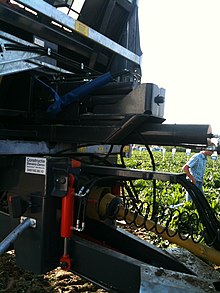Push-off trailer
A push-off trailer is a trailer that unloads the load with the help of a sliding front wall.
Function and structure
The front wall (push-off carriage) is moved backwards with the aid of several telescopic hydraulic cylinders. A volume tailgate is mounted at the rear end . In addition to the actual rear wall, this consists of a piece of about one meter of floor. The loading area is thus extended to the rear without the push-off carriage having to clean it. This section is unloaded by folding up the tailgate. In addition to the actual sliding principle, some variants also work with lifting cylinders to tilt the push-off carriage (consisting of a front wall and a floor area of around one meter attached to it). Push-off vehicles are mostly used in agriculture. Tandem axles are the predominant chassis. Distributor rollers for manure and grass silage are also offered as additional equipment for push-off trailers.
Advantages and disadvantages of the push-off trailer
In comparison to a tipper, the high curb weight should be mentioned. This is mainly due to the more stable side walls. The stability is given at every discharge point. It is possible to compact light loads with the help of the front cylinder with the tailgate closed. In addition to the side walls, this also puts a strain on the hydraulic system and the seals in the front area. In this case, there is particularly heavy contamination around the cylinder. The volume tailgate means that slightly higher buildings are required for unloading. However, this is negligible compared to tipper vehicles.

